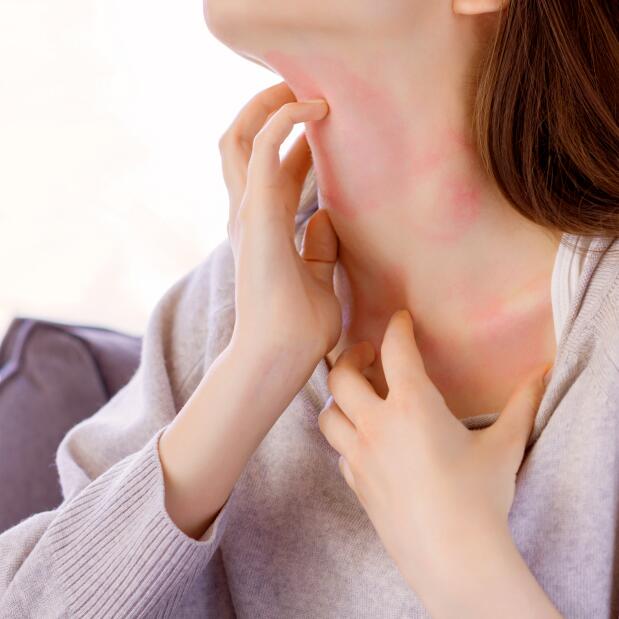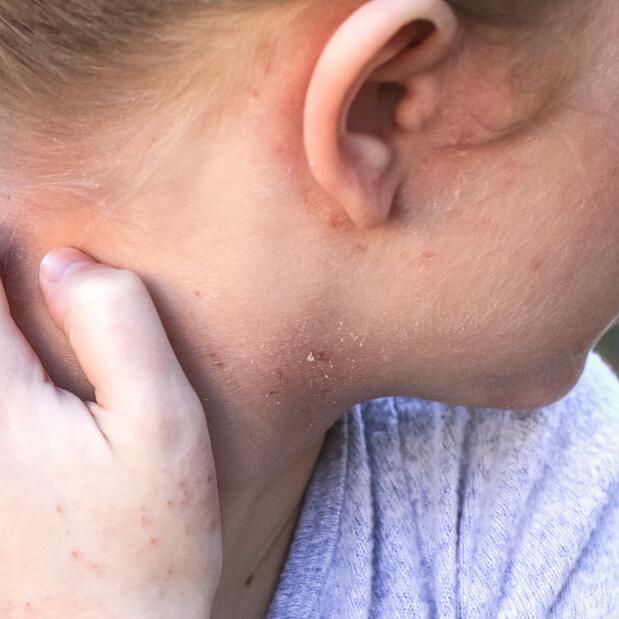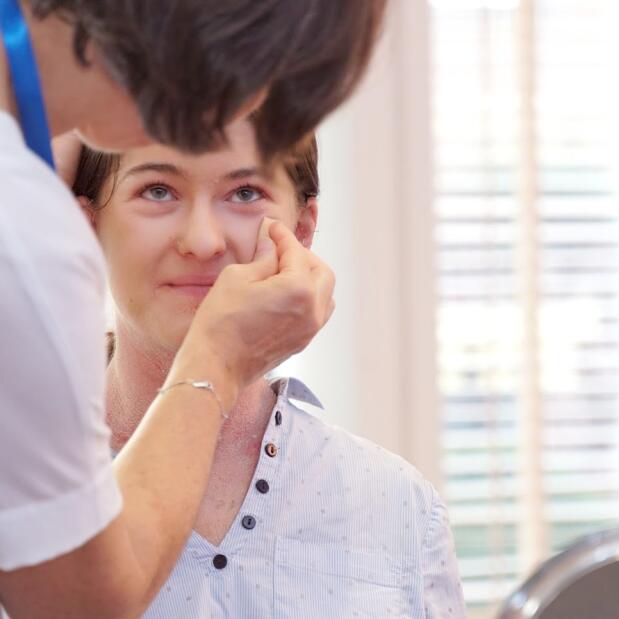Eczema of the face and neck
- Living with eczema and psoriasis
- Psoriasis and eczema for children - rules for moisturizing
- Psoriasis and eczema in adults: suitable hygiene
- Children - Care and anti-itching tips
- Psoriasis and adult eczema - rules for moisturizing
- Psoriasis and eczema in children: suitable hygiene
- Living with eczema and psoriasis: Children
- Living with eczema and psoriasis: Adult
- Adults - Care and anti-itching tips
Eczema of the face and neck
Eczema can occur on all parts of the body. The face (cheeks, forehead, lips or ears) and neck are not spared from red patches and itching. Fortunately, there are solutions to relieve discomfort during flare-ups and protect the thin and fragile skin of the face.

Causes of face and neck eczema
On the face and neck, eczema can be atopic or contact. In the case of the face, it affects infants and adults more. Neck eczema is common in children.
When an allergen is involved, it may be in a lipstick or costume jewellery containing nickel. The allergen may also have been transmitted to the face via the hands, such as through nail polish, or via air, which diffuses pollen in particular. The neck is thus a very exposed area because we often touch it without realising it. And in the winter, it’s in contact with many objects, such as the tags on turtleneck sweaters or woolen scarves, which can irritate the skin.
When the eczema patches reach the face, the disease is visible and the stares of others can be difficult to bear.
Founder of the French Eczema Association Associationeczema.fr
Eczema can also affect the ears
Redness on the earlobe, scabs in the folds, pain or even a strange sensation. Eczema sometimes appears on the ears. When a crack appears in the fold under the earlobe, it’s most likely an atopic form. But contact eczema is also common in this area. We recommend looking for the following causes: costume jewellery earrings, mobile phones, hearing aids, shampoo, hair dye or even ear drops.

Relieving the symptoms of face and neck eczema
Here are the basic rules for relieving eczema flare-ups and soothing the skin on your face over the long term.
Fend off flare-ups on the face and neck
While the treatment of an eczema flare-up on the face and neck is usually a localised cortisone-based treatment or a topical immunosuppressive ointment, the skin needs to be restored outside of the flare-ups. To make it less reactive and to space out these outbreaks, apply an emollient every day.
Soothing the skin on baby's face and neck
In babies, eczema appears on the scalp, cheeks and in the folds of the neck. Red, crusty patches are also sometimes caused by salivation. To reduce flare-ups, apply a suitable emollient several times a day. To treat the outbreak, a dermocorticoid may be prescribed.
FRIENDLY (AND EXPERT) ADVICE
How do you deal with mouth eczema?
When scabs and oozing appear around the mouth and on the lips, this is an eczema flare-up. Whether it’s atopic or contact eczema, the application of a localised corticosteroid provides rapid relief from the associated pruritus, i.e. itching. But this treatment is not enough. It’s essential to apply an emollient care product diligently, even outside the flare-ups. The skin will be better moisturised and protected, and you will be able to space out these outbreaks. You should also avoid touching and licking your lips to prevent stimulating redness. Another tip: if you are a musician, your instrument – a trumpet or clarinet for example – may be the cause of your dermatitis.

Use skin-friendly make-up
Before using a new foundation, test it on a small area of the skin. This will prevent a flare-up of eczema. Use fragrance-free medical make-up or a cleanser. Remove the excess with a disposable tissue. Then spray with Avène Thermal Spring Water and massage the skin to remove any remaining impurities. Finally, dry gently by patting with a soft towel. Replace your products every 3 months.
The cold helps to calm itching and flushing of the skin. So don't hesitate to put your moisturiser in the fridge all day to calm your skin in the evening, if necessary.
Founder of the French Eczema Association Associationeczema.fr
Our solutions to relieve atopic eczema.
Eau Thermale Avène products designed to soothe atopic eczema.
- XeraCalm A.D Lipid-Replenishing Cleansing Oil
XeraCalm
XeraCalm A.D Lipid-Replenishing Cleansing OilNourishes - Soothes - Cleanses - Avène Thermal Spring Water Spray
Thermal Spring Water
Avène Thermal Spring Water SpraySoothes - Restores the skin barrier - Calms - XeraCalm A.D Lipid-replenishing balm
XeraCalm
XeraCalm A.D Lipid-replenishing balmNourishes - Soothes - Hydrates - XeraCalm A.D Soothing concentrateBest Seller
XeraCalm
XeraCalm A.D Soothing concentrateNourishes - Soothes - Restores - Repairs
Which skin care routine should you adopt?
Identify what it really needs with the help of our experts and discover the most suitable skin care routine for you.




